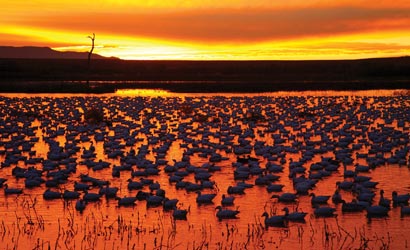How To Photograph Wildlife
You don't always need a super-long lens to take intimate photos of wildlife.

For wildlife photography, a 500mm or 600mm lens is most often the tool of choice — and also a bulky, heavy, and expensive piece of equipment. But there are many times when shorter and wider lenses are simply better. I make it a point to always have both a short zoom lens and an intermediate telephoto lens with me when I am in the field. If you know what to look for, you can make some great nature images — without hauling in the big glass.
Beasts in the Hood
One way to get closer to wildlife is to find places where animals have become acclimated to humans. You’re likely to find such places close to home: Gulls and shorebirds living on beaches or lakeshores frequented by beachcombers, dog walkers, and joggers often let you approach.
In Florida, there are two wading bird rookeries where you can practically touch the herons and egrets nesting next to the boardwalks. Designed primarily as tourist attractions, both the Saint Augustine Alligator Farm and Gatorland, in Kissimmee, provide a wealth of photographic opportunities in spring and summer for folks with short telephoto lenses.
And if you want to mount a major photo excursion, the Galápagos Archipelago in Ecuador is well known for being home to ridiculously approachable wildlife; short lenses can be used effectively there.
For Fast Framing…
One of the real advantages to using a moderate zoom is that it allows you to tailor the framing to the scene quickly. My two favorite zooms are the 28-105mm and the 70-200mm. (Each of these Canon lenses has image stabilization and can be handheld at relatively slow shutter speeds.) Handholding lenses in the 70- or 80-200mm class in particular makes it easy to follow birds in flight or animals in action.
Go Wide
At Bosque del Apache National Wildlife Refuge in south-central New Mexico, large flocks of geese fill the skies from dawn to dusk, spectacular sunrises and sunsets are commonplace, and the low sandstone mountains bathed in that famous Southwestern light provide suitable backdrops for images made with a variety of short lenses. Goose refuges from coast to coast provide similar opportunities. Check with the National Fish and Wildlife Service and local conservation and birding groups for flock ops near you.
Multiply Your Reach
Using a digital SLR body that has a sensor smaller than a single frame of 35mm film provides a real bonus to wildlife shooters by multiplying the effective focal length of your intermediate telephoto lens — with no loss in speed.
Your 200mm lens might become a 260mm, 300mm, 320mm, or 400mm lens depending on your camera. Now add a 1.4X teleconverter and you’ll get 40 percent more focal length on top of that (at the expense of 1 stop of light loss), and if your lens is f/4 or faster you’ll still have autofocus.
You can opt to use a 2X teleconverter, but at this kind of magnification, combined with a 2-stop light loss, it’s recommended that you use a tripod and a gimbaltype tripod head to ensure sharp images. The 2-stop light loss may also disable autofocus; virtually all current AF systems need f/5.6 or faster to function. A 2-stop light loss on your f/4 lens makes it effectively an f/8 lens.
Go Low
By getting low and moving slowly you can often get close enough to your subjects to create three-quarter frame portraits; resist the urge to “fill the frame” as the resulting images will be anything but artistic. Getting really low — such as flat on your belly — can get you very close and yield pleasing out-offocus backgrounds.
Check out Arthur Morris’s latest book on CD, The Art of Bird Photography II ($42, direct) at his web site: birdsasart.com.
SAFETY FIRST
While it is possible to make great images of birds and wildlife with short lenses, be sure to use common sense. If a creature flees once or twice upon your close approach, it is best to look for another subject. Getting close to a deer or a duck will rarely, if ever, get you in trouble. Getting too close to a hawk’s nest, walking up to a moose that’s with a calf, or attempting to photograph a venomous snake with a 100mm lens, however, might leave you injured or worse. There is no substitute for knowing your subjects.